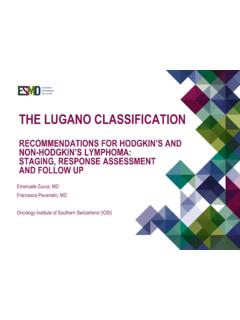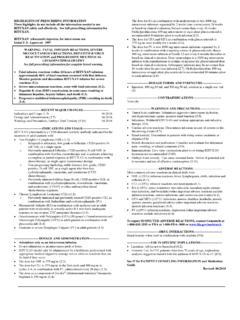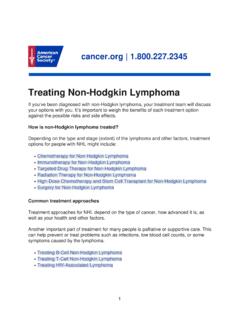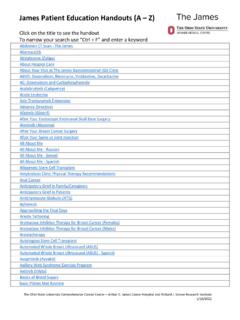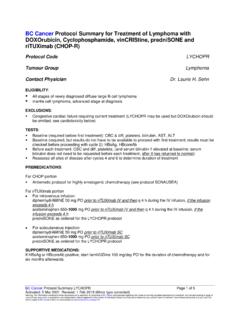Transcription of PRINCIPLES OF CHEMOTHERAPY IN CANCER
1 PRINCIPLES OF CHEMOTHERAPY . IN CANCER . Prof. N. PAVLIDIS. ESMO/ESO COURSE, Valencia, July 2019. DISCLOSURE OF INTEREST. Nothing to declare HISTORY OF CHEMOTHERAPY . THROUGH THE YEARS. The First Chemotherapeutic Agent Found On December 2, 1943 Bari's harbor was bombed by a flight of 105 German bombers. Among the 24 ships of the alliance, one ship named SS John Harvey was carrying a secret cargo of 100 tons of liquid mustard gas. Many seamen on surrounding ships who survived developed blistering of epithelial surfaces, reduced white blood cells and profound lymphoid and myeloid suppression on autopsies. Using this information Goodman and Gilman two pharmacologists from the Yale School of Medicine - reasoned that this agent could be used to treat lymphoma. INTRODUCTION. CANCER CHEMOTHERAPY is a modality of CANCER therapy that involves the administration of chemical agents to destroy CANCER cells. The aim of CANCER CHEMOTHERAPY is to cure where possible and palliative where cure is impossible The effective use of CHEMOTHERAPY needs a deep understanding of the PRINCIPLES of tumor biology, cellular kinetics, pharmacology and drugs resistance RESULTS OF CHEMOTHERAPY .
2 THROUGH THE YEARS (1949-2015). C hemotherapy 1. Can cure CANCER (even in advanced stages). Germ cell tumors ( testicular CANCER ). Hodgkin's disease Non Hodgkin's lymphomas Gestational choriocarcinoma Pediatric tumors ( lymphomas, leukemias neuroblastoma, bone sarcomas ). 2. Can achieve considerable prolonged survival ( in advanced stages ). Breast CANCER Ovarian CANCER Colorectal CANCER Lung CANCER Other hematological malignancies ( leukemias, myeloma). 3. Can achieve prolonged progression-free survival (as an adjuvant treatment in non-metastatic disease). Breast CANCER Colorectal Ovarian CANCER ALKYLATING AGENTS. Mechanism of action: Target DNA, produce alkylation through formation of intermediates. No phase-specific drugs Busulfan Melphalan Chlorambucil Nitrosoureas Cisplatin, Carboplatin, Oxaliplatin Procarbazine cyclophosphamide , Ifosfamide Streptozotocin Dacarbazine Temozolomide Mechlorethamine (Nitrogen Mustard) Thiotepa ANTIMETABOLITES. Mechanism of action : Interfere with DNA synthesis.
3 They are structural analogs or they inhibit several enzymes. S-phase specific Mercaptopurine Aracytidine Methotrexate Cytarabin Pemetrexed Fludarabine Pentostatin Fluorouracil Raltitrexed Leucovorin Thioguanine Capecitabine Trimetrexate Gemcitabine Uracil / Tegafur (UFT). Hydroxyurea ANTITUMOR ANTIBIOTICS. Mechanism of action: Cause linkage of double strands of DNA. and prevent replication. They are derived from microorganisms. Cell cycle specific drugs. Actinomycin D Epirubicin Bleomycin Idarubicin Daunorubicin Mitomycin doxorubicin Mitoxantrone doxorubicin Liposomal MITOTIC SPINDLE AGENTS. Mechanism of action: Bind to microtubular proteins, thus inhibit microtubule assembly resulting in dissolution of the mitotic assembly structure. M- phase specific drugs. Docetaxel vincristine Paclitaxel Vinblastine Paclitaxel Albumin Vinorelbine Cabazitaxel Eribulin (Non-taxane tubulin binding agent A marine sponge product). TOPOISOMERASE INHIBITORS. Mechanism of action: DNA Topoisomerases I and II are essential enzymes for transcription, replication and mitosis.
4 The following drugs are able to inhibit these enzymes. Topoisomerease I inhibitors Topoisomerase II inhibitors Irinotecan Etoposide Topotecan Teniposide MISCELLANEOUS AGENTS. Asparaginase Hexamethymelamine Estramustine Octreotide Velcade MODES OF CHEMOTHERAPY . ADMINISTRATION. Intravenous Oral Local Drug Application Intra-arterial ( hepatic infusion, limb perfusion). Intra-thecal (menengeal metastasis). Intra-peritoneal (ovarian CANCER , peritoneal carcinomatosis). Intra- pleural (pleurisy / pleural metastases). Intra-pericardial (malignant pericardial effusion). PRINCIPLES OF COMBINATION. CHEMOTHERAPY . Use drugs active as a single agent Use drugs with different mechanisms of action Use drugs with different mechanisms of resistance Use drugs with different side-effects Be aware of drug-drug interactions COMMON COMBINATION. CHEMOTHERAPY REGIMENS. CANCER Type Drugs Acronym Breast CANCER cyclophosphamide , methotrexate, 5-FU CMF. doxorubicin (Adriamycin), cyclophosphamide AC.
5 doxorubicin (Adriamycin), Paclitaxel (Taxol) AT. Hodgkin's disease Mustine, vincristine (Oncovin), Procarbazine, MOPP. prednisone doxorubicin (Adria), bleomycin, vinblastine, ABVD. dacarbazine Non-Hodgkin's cyclophosphamide , doxorubicin , vincristine , CHOP. lymphoma prednisone Germ cell tumor Bleomycin, etoposide, cisplatin BEP. Stomach CANCER Epirubicin, cisplatin, 5-FU ECF. Bladder CANCER Methotrexate, vincristine , doxorubicin , cisplatin MVAC. Colorectal CANCER 5-FU, folinic acid, oxaliplatin FOLFOX. RATIONALE OF SYSTEMIC. CHEMOTHERAPY . 1. NEOADJUVANT CHEMOTHERAPY [PREOPERATIVELY]. To make non-operable tumors operable Rationale To achieve organ preservation To select sensitivity for specific treatment (biomarkers). 2. ADJUVANT CHEMOTHERAPY [POSTOPERATIVELY]. To kill micrometastatic disease Rationale To increase disease-free survival 3. PALLIATIVE CHEMOTHERAPY . CHEMOTHERAPY given to control symptoms or prolong life in a patient in whom cure is unlikely 4. SALVAGE CHEMOTHERAPY .
6 A potentially curative, high-dose regimen given in a patient who has failed or recurred following a prior curative regimen. 5. INDUCTION CHEMOTHERAPY . The intent is to induce complete remission when initiating a curative regimen (usually applied to hematologic malignancies). 6. CONSOLIDATION CHEMOTHERAPY . Repetition of the induction regimen in a patient who has achieved a complete remission after induction, with the intent of increasing cure rate or prolonging remission. 7. DOSE INTENSIFICATION CHEMOTHERAPY . Strategy to overcome drug resistance through: (i) highest possible dose (ii) shortest possible intervals (iii) with supportive use of G-CSF. 8. DOSE INTENSIFICATION CHEMOTHERAPY . Marrow-ablative doses of CHEMOTHERAPY to increase tumor cell-kill, while rescuing the host with: (i) autologous bone marrow (ii) donor bone marrow (iii) peripheral stem-cells 9. MAINTENANCE CHEMOTHERAPY . Long term, low dose, single or combination CHEMOTHERAPY in a patient who has achieved a complete remission, with the intent of delaying the regrowth of residual tumor cells.
7 10. METRONOMIC CHEMOTHERAPY . Oral chronic administration of CHEMOTHERAPY ( cyclophosphamide , etoposide, vinorelbine) has both antitumorigenic and antiangiogenic effect on tumor endothelial tumor cell. Endothelial cells are 10-100 times more susceptible to CHEMOTHERAPY . 11. CHEMORADIATION. Integration of CHEMOTHERAPY with radiotherapy Drugs commonly use are 5-FU and Cisplatin Enhancement of tumor response (radiosensitization). Protection of normal tissue EVALUATION OF RESULTS. ( EFFICACY ). PARAMETERS TO BE EVALUATED IN. SYSTEMIC TREATMENTS. RESPONSE (Response Evaluation Criteria In Solid Tumours RECIST 2000). COMPLETE RESPONSE (CR) : Disappearance of all target lesions PARTIAL RESPONSE (PR) : At least a 30 % decrease in the sum of the longest diameter (LD). of targeted lesions STABLE DISEASE (SD) : Neither sufficient shrinkage to qualify for PR nor sufficient increase to qualify for PD. PROGRESSIVE DISEASE (PD) : At least a 20% increase in the sum of the LD of targeted lesions.
8 DURATION OF RESPONSE : The time from response to OR TIME TO PROGRESSION (TTP) progression PARAMETERS TO BE EVALUATED IN. SYSTEMIC TREATMENTS. SURVIVAL. DISEASE-FREE SURVIVAL (DFS) : From the time of treatment to first recurrence OVERALL SURVIVAL (OS) : From the time of diagnosis to death PRE- CHEMOTHERAPY . ASSESSMENT. Full blood count (Hb, WBCs, Plts). Renal function (creatinine, GFR). Liver function (enzymes, bilirubin). Avoid 3rd space occupation (excessive ascites or pleurisy). Performance status (ECOG Scale). CHEMOTHERAPY TOXICITY. CHEMOTHERAPY TOXICITIES (I). TOXICITY DRUG INDUCED ANTIDOTE. Bone marrow suppression Erythropoietin, G-CSF, (anemia, leucopenia, Almost all blood transfusions thrombocytopenia). Nausea-vomiting Platinum 1. Serotonin receptors antagonists Anthracyclines 2. NK 1 receptor antagonists Alkylatings 3. Tacykinin, 4. Olanzapine Alopecia Scalp-cooling techniques Anthracyclines (not universally accepted). Taxanes Anthracyclines Cardiotoxicity cyclophosphamide Early detection.
9 5-FU Dexrazoxane CHEMOTHERAPY TOXICITIES ( II ). Pulmonary toxicity Bleomycin Early detection. Alkylatings Corticosteroids Gemcitabine Nephrotoxicity Platinum Adequate hydration Methotrexate ( dose). Neurotoxicity Alkaloids Platinum Early detection Taxanes Alkylatings Gonadal damage Sperm preservation Others Avoid if possible Second malignancies Alkylatings responsible drugs and/or RT in curable diseases RESISTANCE. TO. CHEMOTHERAPY . RESISTANCE TO CHEMOTHERAPY . Primary Resistance When the CANCER does not respond to standard CHEMOTHERAPY from the very first exposure Acquired Resistance When the tumour initially responds to CHEMOTHERAPY and then becomes resistant. MECHANISMS OF RESISTANCE. TO CHEMOTHERAPY (I). CANCER cells may be mutated & develop pathways that are independent of those blocked by cytotoxic drugs. Gene amplification may lead to overproduction of proteins that are blocked by anticancer drugs. MECHANISMS OF RESISTANCE. TO CHEMOTHERAPY (II). CANCER cells may develop mechanism that inactivate anticancer drugs.
10 They may learn to repair the DNA & protein damages induced by anticancer drugs. (leading to). Resistant clones of CANCER cells may develop. THANK YOU.
